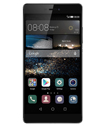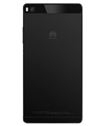The Samsung S6 edge has set such high standards for its competitors that coming close to it in a tightly knit Android industry is increasingly tough. Last year, when Huawei released it flagship Ascend P7, they got us excited with a high-performing, premium packaged smartphone in a beautiful slender chassis. In the long run, rigorous, consistent implementation of technology and the quality is imminent for the company to remain competitive with its peers.
With its latest introduction, Huawei deserts the Ascend moniker, simply naming the phone P8. Judging by the looks, the P8 has improved in various areas, particularly specs and design. But does it keep up with the same level of quality, stability and promise that Apple and Samsung offer?
Look, Design, Feel (/10)

Looks wise, the P8 looks more or less like its predecessor, the Ascend P7. The premium hard-lined design of P8 that’s evenly flat on the front and back is accentuated further by its chiselled curved edges. Going by the materials used, the smartphone gives us the feel of a sturdy, strong construction that feels solid to hold in the hand. The P8 features the power button, volume controls, microSD slot, SIM slot on its right, the 3.5mm headphone jack and noise-cancelling mic on its top edge, microUSB port, microphone, and speaker along the bottom side of the phone. The power and volume buttons are the only physical buttons on the P8, and they sit so closely next to each other that it's easy to hit the wrong button.
These days, where quad-HD screens are becoming extremely popular, Huawei has opted for 5.2-inch 1080 x 1920 JDI IPS-Neo display. This also means it is one of finest full HD screens till date, allowing for big, bright and readable details for both near and far viewing. The P8's screen is one area where it impresses one and all.
Features (/10)

The Huawei P8 favours the new EMUI 3.1 experience to run on top of Android 5.0 Lollipop. In comparison to recent Android experiences, this one opts for simplicity over functionality. Perceivably its got a very clean look that does away with traditional apps. But the resulting jumbled and messy look of all the icons can repel quite a few. Secondly, the interface appears bizarrely similar to iOS, including the shape of its icons and Spotlight Search function. The P8’s front-facing 8-megapixel camera is good for taking selfies, plus it features additional modes that expand the experience.
The 13-megapixel RGBW sensor camera developed by Sony is the main highlight of Huawei P8. It delivers better performance in low light conditions. Besides, the camera interface is loaded with a number of modes and manual controls including HDR and panoramic and the rarely found time lapse, all-focus, super night, and light painting.
The Huawei P8 is powered by 64-bit HiSilicon Kirin 930 chipset, consisting of two ARM Cortex-A53 quad-cores in a big.LITTLE configuration. Clocked to 2.0GHz, one quad-core set handles intense applications while the other 1.5GHz quad-core effectively takes care of functionality and operations such as web browsing, calls, messaging, music and more. For the most part, the P8 did its job well, responding well to intense tasks. There're some minor freezing and lagging, but that should be neutralized by opening the apps wisely.
Connectivity (/10)
The Huawei P8 allows quad-band 2G/GPRS/EDGE support and 3G with HSDPA. This equates to 42.2 Mbps download speeds and 5.76 Mbps upload. It is also equipped with Cat. 6 LTE, competent of up to 300 Mbps downstream. The P8 is a Dual SIM phone, but the SIM also operates as a microSD card, meaning you can use it only for either purpose. Local connectivity is offered by Dual-band Wi-Fi 802.11 a/b/g/n with three new connectivity features including Wi-Fi+, Signal+, and Roaming+. Regular connectivity options such as Bluetooth 4.1, microUSB 2.0 port with USB Host, GPS/GLONASS and BeiDou (BDS) navigation complete the details.
Performance (/10)
The Huawei P8 is spot on with its performance, especially in the call department where the voices are strong, vibrant, and audible on the other end of the line as well. The speakerphone is top-notch, clear and powerful, even in noisy environments.
The P8 comes inbuilt with a 2680 mAh battery, which delivers a standard one-day of operation from a normal charge. But it takes a painstakingly 3.5 hours to charge from critical to 100%. Though some of its peers charge in half the time, the P8 still winds up being a huge performer.
Value for Money (/10)
Sure, Huawei is not a big brand as Apple or Samsung, but don't rule it out. It could turn out to be the best value phone of the year if it gets the attention it deserves. It is much cheaper than its competitors and has all the features a flagship phone should have. An amazing processor, a better than ever 13-megapixel main camera and a great screen. Its specs and performance rival some of the biggest releases this year, including the Galaxy S6 and HTC One M9.
Pros
- Exclusive metal design
- Top ranking images
- Cheaper than most other flagship phones
- Expandable storage
Cons
- EMUI 3.1 experience is clumsy and somewhat a copy of Apple's iOS
- Insufficient performance with graphics processing
- Dull 1080p videos
